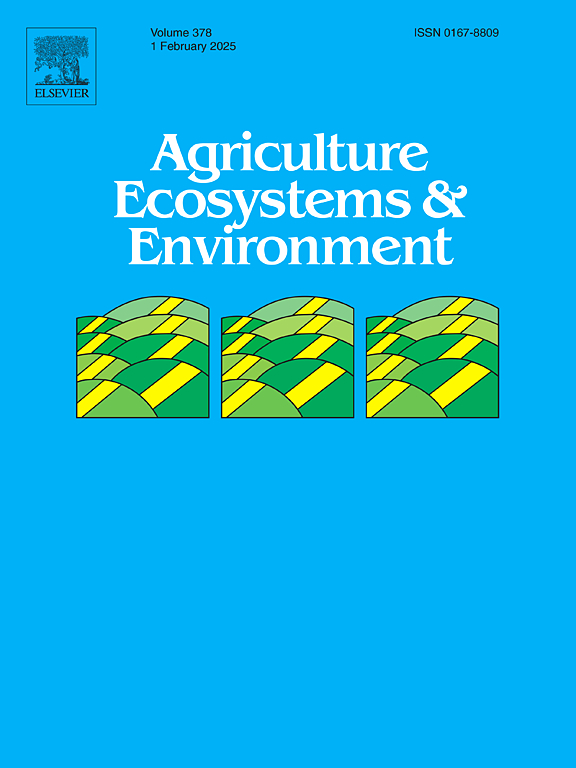森林放牧系统减少了土壤二氧化碳排放,增加了碳储量,并调节了热带放牧地的微环境
IF 6
1区 农林科学
Q1 AGRICULTURE, MULTIDISCIPLINARY
引用次数: 0
摘要
土壤二氧化碳通量是全球碳循环的一个基本组成部分,可通过土地利用和管理做法加以调节。林牧复合系统(包括牧区树木)可以增加碳储量,减少土壤CO2通量,但其与小气候、土壤性质和植被属性的关系尚未得到很好的研究。本研究的目的是评估3种不同类型的森林放牧系统的碳储量和土壤CO2通量,并揭示微气候变量、土壤性质和植被特征之间的联系:1)分散的草地树木、2)人工林下的放牧、3)牧场周围的围栏和4)阳光充足的牧场。使用EGM-5气体分析仪连接土壤呼吸室(PP Systems, USA),原位测量土壤CO2通量12个月。利用结构方程模型分析了植被特征、土壤性质和小气候变量对土壤CO2通量的相对贡献。土壤CO2通量在森林放牧系统和全日放牧系统之间存在显著差异(p <; 0.01),变化范围为0.59 ~ 0.87 g m−2 hr−1,其中全日放牧系统的通量最高,其次是草地围篱、草地分散的树木和人工林下的放牧。与全光照牧场相比,森林放牧系统减少了12 - 32% %的土壤二氧化碳通量。100 cm深度的土壤有机碳储量,人工林放牧(187 Mg C ha - 1)和分散的林荫系统(215 Mg C ha - 1)分别比全日放牧(167 Mg C ha - 1)高12 %和29 %。土壤温度、空气温度和相对湿度在不同的放牧系统之间也存在显著差异,其中全日照草地(草单一)的温度最高,相对湿度最低。在结构方程模型中,土壤CO2通量与植被属性(包括每公顷乔木数和生物量)呈负通径系数(-0.82,p = 0.03),与小气候变量呈显著协变。土壤性质结构不是CO2通量的强预测因子,但与植被(包括植物生物量和凋落物储量)呈正相关。虽然对土壤微生物活动的进一步研究可能有助于更好地了解这些畜牧农林业系统之间的土壤CO2通量模式,但本研究表明,树木的存在改变了放牧地的微环境条件,从而减少了土壤CO2排放并增强了碳固存。研究结果对设计气候智慧型和环境友好型畜牧生产系统具有重要意义。本文章由计算机程序翻译,如有差异,请以英文原文为准。
Silvopastoral systems reduce soil CO2 emissions, enhance carbon stocks, and regulate the micro-environment in tropical grazing lands
Soil carbon dioxide (CO2) flux is a fundamental component of the global carbon cycle and can be regulated by land use and management practices. Silvopastoral systems, livestock agroforestry that includes trees in grazing lands, can increase carbon storage and reduce soil CO2 fluxes, yet their relationship with micro-climate, soil properties, and vegetation attributes has not been studied well. The objective of this research was to evaluate carbon storage and soil CO2 fluxes and decipher the linkage between micro-climatic variables, soil properties, and vegetation characteristics in three silvopastoral systems: 1) dispersed trees in pasturelands, 2) grazing under forest plantations, and 3) live fences around pastureland, and 4) full-sun pastureland. Soil CO2 fluxes were measured in situ using an EGM-5 gas analyzer connected with a soil respiration chamber (PP Systems, USA) over twelve months. Structural equation modeling was used to untangle the relative contribution of vegetation characteristics, soil properties, and micro-climatic variables on soil CO2 fluxes. Soil CO2 flux varied significantly between silvopastoral systems and full-sun pasturelands (p < 0.01), ranging from 0.59 to 0.87 g m−2 hr−1, with the full-sun pastureland having the highest flux, followed by live fences around pastureland, dispersed trees in pasturelands, and grazing under forest plantations. Silvopastoral systems reduced 12 – 32 % of soil CO2 fluxes compared to the full-sun pasture. Soil organic carbon stocks to 100 cm depth were 12 % and 29 % higher in grazing under forest plantations (187 Mg C ha−1) and dispersed tree silvopastoral systems (215 Mg C ha−1), respectively, than in full-sun pasturelands (167 Mg C ha−1). Soil temperature, air temperature, and relative humidity also differed significantly between pastoral systems, with the full-sun pasture (grass monoculture) having the highest temperature and the lowest relative humidity. In a structural equation model, soil CO2 flux showed a negative path coefficient (-0.82, p = 0.03) with vegetation attributes that include the number of trees per hectare and biomass stocks, which covaried significantly with the micro-climatic variables. The soil properties construct was not a strong predictor of CO2 flux but covaried positively with vegetation, including plant biomass and litter stocks. While further studies on soil microbial activities may help better understand the patterns of soil CO2 fluxes among these livestock agroforestry systems, this study shows that the presence of trees modifies micro-environmental conditions in grazing lands, thereby reducing soil CO2 emissions and enhancing carbon sequestration. The results have important implications in designing climate-smart and environment-friendly livestock production systems.
求助全文
通过发布文献求助,成功后即可免费获取论文全文。
去求助
来源期刊

Agriculture, Ecosystems & Environment
环境科学-环境科学
CiteScore
11.70
自引率
9.10%
发文量
392
审稿时长
26 days
期刊介绍:
Agriculture, Ecosystems and Environment publishes scientific articles dealing with the interface between agroecosystems and the natural environment, specifically how agriculture influences the environment and how changes in that environment impact agroecosystems. Preference is given to papers from experimental and observational research at the field, system or landscape level, from studies that enhance our understanding of processes using data-based biophysical modelling, and papers that bridge scientific disciplines and integrate knowledge. All papers should be placed in an international or wide comparative context.
 求助内容:
求助内容: 应助结果提醒方式:
应助结果提醒方式:


